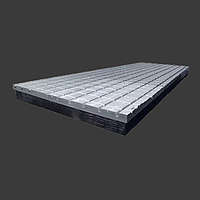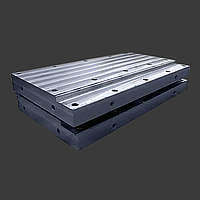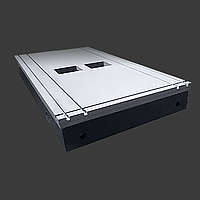The Stolle family business, now in its fourth generation, specializes in clamping plates and produces castings weighing up to 25 tons for machine tool manufacturing, measurement technology and test bench construction. The individually different raw castings are formed and cast in molding pits in the company's own foundry. After tipping and deburring, there are molding sand residues, mineralizations and other foundry deposits on the tipped castings that have to be removed. Stolle has been using a roller table blast machine for this purpose since 1988. Without the blasting process, further machining would hardly be possible due to the high wear of the tools.
However, the blast machine, which was almost 35 years old, was slowly reaching its limits and could no longer meet today's quality requirements. Since a retrofit was not an option here, Stolle invested in a new roller conveyor shot blast machine from Agtos at the end of 2021. "When a system is more than 30 years old, a retrofit usually can't do much. We would have had our plant virtually like new, but at a very high price. In addition, the quality demand today is simply different than it was 30 years ago," explains Managing Director Martin Stolle.
Process speed significantly increased
In addition to higher quality, the system should also improve the process flow and reduce working time and energy costs. "Whereas the old system required two to four blasting processes per workpiece, one blasting process is now sufficient. This also reduces our power consumption," Stolle continues. "This is made possible above all by the 3-fold increase in the number of turbines," adds foundry production manager Florian Lorenz. Another time-saving factor is the automatic cleaning of the workpiece surfaces after the blasting process by means of appropriate brushing and blowing devices. With the old system, these steps still had to be carried out by hand and involved heavy physical labor.
Fully automatic processing
The new system is a so-called all-in-one system with an integrated filter system, which is located on top of the machine to save space. For the blasting process, the castings are placed on the infeed roller table and the process is started by pressing a button. After the start of the roller table, the workpieces activate the light barrier located in front of the infeed airlock for automatic blast media supply. This ensures that blasting only takes place when workpieces are in the blasting area. The light barrier is also used to set the cleaning system to the correct height: Depending on the thickness of the parts to be blasted, the brush aligns itself accordingly, thus avoiding too rapid brush wear.
The inlet sluice is equipped with wear-resistant rubber curtains for sealing. Sealing from below is provided by rubber seals.
Technical data of the blasting machine
- Blasting task: Sand removal
- Workpiece designation: Machine bed tables
- Cleaning quality: Desanding
- Capacity:> 20 parts in 8 h
- Workpiece material: Grey cast iron
- Workpiece temperature:< 60°C
- Throughput speed: - 0,5 m/min.
- Max.part dimensions (Lx W x H):8000 x 3200x 1000 mm
- Throughput width: 3200 mm
- Passage height: 1000 mm
- Roller pitch: 800 mm
- Sound pressure level with sound insulation: approx. 85 dB(A)
Characteristics of the installed turbine
- Number: 12 pieces
- diameter: 350 mm
- Type: 3.6
- Number of blades: 6 pieces
- Drive power per turbine: 11,0 kW
Characteristics of installed filtration system
- Type: 2 x Agtos PF 4b-32-NO-05-AB
- Volume capacity: 24.000 m3/h
- Filter area: 256 m'
- Residual dust content with post-filter: s 0.15 mg/Nm'.
Blasting is carried out with a cast steel abrasive with a grain size of 1.25 to 2.00 mm, which is kept in circulation and cleaned for continuous use. The cleaned abrasive is fed fully automatically from the abrasive bunker to the high-performance turbines via the abrasive metering system. The undersize is recyclable as a waste product.
The geometry of the workpieces means that large quantities of molding sand are present in the abrasive during the blasting process. A solution was therefore created to allow parts of the abrasive to pass through the circuit several times during and after the blasting process so that it is optimally cleaned. This measure made it possible to dispense with magnetic/wind sifting, which is otherwise common in the foundry sector, and to avoid investment costs.
Three to five workpieces per day
The blast machine currently blasts around three to five workpieces per day. A blasting process takes around 20 to 25 minutes - depending on the size of the workpiece to be processed. Necessary maintenance measures are indicated in good time on the machine display. In case of malfunctions, direct remote maintenance by Agtos is also possible.
Both Stolle and Agtos are pleased with the successfully completed project. "We are very satisfied with the consulting, the project work and the support after the start of production by Agtos. The installation of the plant went smoothly according to the project plan, so that the plant went into operation on schedule in December 2022," reports Lorenz. For Agtos itself, the plant was special: "Normally, castings in foundries are transported hanging. In order not to interrupt the flow, overhead conveyor shot blast machines are usually used here. This is the first time we have designed a roller conveyor shot blast machine for a foundry. But since we see ourselves as special machine builders, we were happy to accept this challenge," says Ulf Kapitza from Agtos.





